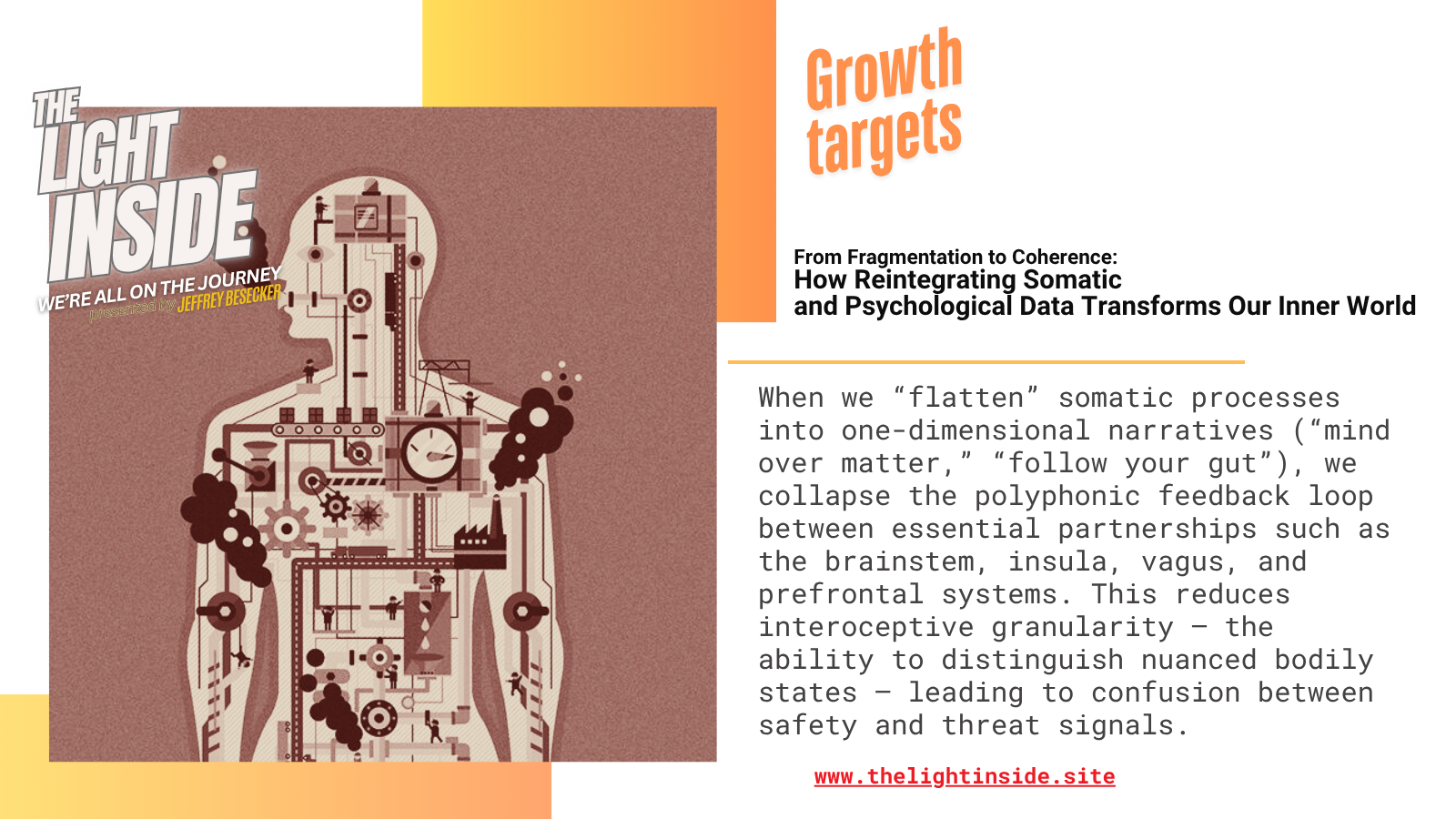From Fragmentation to Coherence: How Reintegrating Somatic and Psychological Data Transforms Our Inner World

Have you ever wondered how oversimplifying the nuanced dialogue between your head, heart, and gut might keep you from feeling truly aligned and alive?
When we oversimplify the living dialogue between the sub-systems of our biological processes we lose the subtle intelligence of our embodied systems—mistaking stress for truth, arousal for intuition, and noise for meaning—fracturing the very coherence that allows us to feel whole, attuned, and alive Yet, many people are conditioned to unconsciously believe they operate from a dominant internal system (head, heart, or gut) while the others lie fallow; this misalignment produces somatic incoherence — tight chest, shallow breath, digestive disruption, rumination — that then gets misread as rigid personality associations, diagnosis, or moral failing.
Enter Arousal Misattribution and Meta-cognitive Dissonance
This episode explores how human behavior is dynamically shaped by the interplay of unresolved emotional and cognitive patterns, somatic feedback loops, and contextual cues, highlighting how habitual dissociation, epistemic flattening, and maladaptive coping mechanisms distort perception, intuition, and relational attunement.
By examining the recursive interplay of transference, counter-transference, over- and under-vigilance, and filtered distortions—the episode illuminates how both clients and clinicians unconsciously mirror and perpetuate trauma-bound narratives.
The central theme emphasizes that sustainable growth, emotional regulation, and adaptive behavior emerge not from simplistic solutions or non-judgmental neutrality alone, but from intentional integration of disowned parts, reflective discernment, and nuanced attunement to the layered interactions between mind, body, and environment.
Core primary behavior to anchor the episode:
Reductivism: Meta-cognitive filters, epistemic flattening, and adaptive coping mechanisms
Misalignment of embodied decision-systems — the chronic dominance of one internal “brain” (Head, Heart, or Gut) while the others are suppressed, producing somatic incoherence (bracing, vagal dysregulation) that drives self-sabotage, indecision and relational rupture
The misattribution and epistemic flattening of our Head, Heart, and Gut Processes (epistemic reductivism or overgeneralization of somatic incoherence, meta-cognitive dissonance, emotional dysregulation) — and how this disconnect drives self-sabotage, chronic stress, indecision, and unfulfilling relationships.
Key Point of Contention (relative and context-dependent)
Disruptions in any node or sub-system of somatic function and ego processes (e.g., HPA hyperactivation, amygdala overdrive, insular suppression) creates identity fragmentation, while restored flow across systems supports self-coherence and unitive integration.
Single-word theme:
Integration.
What happens when clinicians and clients reduce complex embodied experience to a single channel (“listen only to your gut” or “just think it through”)
This question gets to the crux of our current episode and a deeper awareness we’ve been building across The Light Inside:
That epistemic flattening of human behavior — reducing emergent, dynamic embodied processes to singular, simplistic explanations — is not just a cognitive error, but a systemic source of interpersonal and societal incoherence.
Ontological Shortcoming and Epistemic Flattening:
Below is a detailed, evidence-grounded analysis that integrates neurobiological, psychological, and sociological dimensions, followed by a cohesive narrative illustration.
Christoffel and I explore the impact of this misalignment, highlighting how concepts like HRV and polyvagal theory provide measurable insights into regulation. We illustrate brief, clinician-safe micro-practices that help reintegrate unresolved psychological material, guiding clients from reactive survival patterns toward present-moment, embodied choices—empowering us to understand the richly dynamic context these nuanced sub-systems bring when informing our actions, behaviors, choices, and personality qualities
Top Three Salient Shortcomings of Ontological and Epistemic Flattening
(in understanding the emergent interplay of our integrated somatic sub-systems)
1. Loss of Interoceptive Differentiation → Emotional and Somatic Dysregulation
Empirical basis: Studies in interoceptive neuroscience (Critchley & Garfinkel, Nat Rev Neurosci, 2017; Khalsa et al., Biol Psychol, 2020) show that the ability to sense, interpret, and regulate internal bodily signals (heartbeat, breath, gut motility) predicts emotional clarity, cognitive flexibility, and empathic attunement.
When we “flatten” somatic processes into one-dimensional narratives (“mind over matter,” “follow your gut”), we collapse the polyphonic feedback loop between essential partnerships such as the brainstem, insula, vagus, and prefrontal systems. This reduces interoceptive granularity — the ability to distinguish nuanced bodily states — leading to confusion between safety and threat signals.
Resulting shortcoming:
A disconnection from somatic nuance amplifies dysregulation: for instance; hyperarousal is mistaken for passion; numbness for calm; defensive rigidity for confidence. This emotional imprecision is the ground zero for avoidant coping and relational misattunement.
2. Reduction of Emergent Relational Dynamics → Breakdown of Co-regulation and Social Cohesion
Empirical basis: Polyvagal theory (Porges, 2011), affective neuroscience (Schore, 2021), and social baseline theory (Coan & Sbarra, 2015) converge on one fact: human regulation is relational.
- Our ventral vagal complex and limbic mirror networks evolved to stabilize through mutual attunement.
Epistemic flattening — i.e., attributing behavior to “personality,” “willpower,” or isolated mental states — erases the emergent interplay between somatic states and environmental context.
Resulting shortcoming:
Without recognizing this interdependence, we create false autonomy: the illusion that self-regulation occurs in isolation.
- This diminishes empathy, fosters moralization (“you should just calm down”), and fragments social coherence.
In essence, flattening the relational body erodes the connective web of society — mutual regulation — replacing co-existence with competition for psychic safety.
3. Ignoring Feedback Loops Between Environment and Somatic Systems → Perpetuation of Systemic “Noise”
Empirical basis: Embodied cognition and enactivist models (Varela, Thompson & Rosch, 1991; Clark, 2013) show meta-cognition as a distributed process — arising from body–environment coupling.
When epistemic flattening denies this circularity, we overemphasize the illusion of control (“fix your mindset”) and under-recognize contextual entrainment — how sensory, relational, and ecological feedback continually shape neural and affective patterns.
Resulting shortcoming:
This conceptual blind spot (biased heuristic, or ‘shortcut’) creates a self-reinforcing feedback loop of incoherence: internal dissonance amplifies social misunderstanding, which then mirrors back as environmental stress (e.g., social polarization, chronic anxiety).
The “noise” of unintegrated data and feedback drowns out signals of genuine connection and understanding--not by "muting" or flattening logical data and reasoning, but guiding it out of circular, ruminated, or recursive loops of feedback.
Integral Role in Personal and Social Cohesion
Somatic coherence — the balanced integration of head, heart, and gut systems — forms the foundation of social coherence, a measurable phenomenon where shared physiological synchrony (e.g., HRV entrainment, gaze coherence, conversational rhythm) enhances empathy, trust, and group coordination.
Studies by McCraty et al. (2017) and Schilbach et al. (2013) demonstrate that interpersonal physiological coherence fosters cooperation and shared intentionality.
When individuals cultivate embodied coherence (unified sub-systems), they contribute to collective regulation: communities that cohere under stress rather than fragment. Conversely, when somatic sub-systems remain fragmented, the result is emotional contagion without awareness — reactive echo chambers that amplify fear, outrage, and misattribution.
Thus, coherence is not a luxury of wellness culture; it is the biological infrastructure of civilization.
Illustrative Example: Flattening at Play
“Your nervous system doesn’t know the difference between a deadline and a tiger.”
Or does it?
Here’s the coachable insight: while both can activate the same stress circuits—your HPA axis, amygdala, and salience network—the difference lies in how dynamic sub-systems influence meaning. Through appraisal and narrative, the prefrontal cortex interprets context, deciding whether you’re facing mortal danger or just a demanding to-do list.
When prior experiences, neural imprinting, or low vagal tone bias perception, even a neutral cue — like a simple calendar alert — can register as a potential threat. Each of our somatic sub-systems “attunes” to sensory input through distinct roles: some detect and regulate physiological states, while others construct the emotional and cognitive meaning we assign to those sensations.
Expecting one sub-system to perform the function of another is like expecting a stick to behave like a dog — a fundamental category error occurs.
Here’s We’re The Error Matters:
The problem isn’t in the stimulus or the body’s response, but in the misassigned attribution — we’re asking the wrong internal “department” to handle a task it was never designed to perform.
Often, the nervous system couples these processes in ways that blur their boundaries.
For instance: von Economo neurons — critical for rapid affective appraisal — modulate salience network activity, linking visceral sensory data to affective forecasting. In such moments, a neural response (physiological activation) and a cognitive task (value-based meaning construction) occur simultaneously, creating the illusion that one system’s role belongs to another.
Similarly, afferent and efferent signaling continually interact to balance top-down and bottom-up processes, shaping how we anticipate, interpret, and respond to context. When these channels become dysregulated or misattributed, perception itself becomes distorted — and what is simply data from the body begins to feel like danger from the world.
This demonstrates how all neural interactions do not act or behave in the same way, or by addressing a universal function—the context becomes relational; and therefore situationally dependent.
Neural interactions are not universally uniform but are contextually modulated, relationally co-determined, and situationally dependent. This reflects the dynamic, adaptive, and emergent nature of neural systems—where meaning and behavior arise not from fixed structures, but from the fluid relationships among brain, body, and environment.
In many regards—we’re engaging the rule of measure bias and faulty affective forecasting—calling on misidentified areas of our nervous system to over form roles they have not inherently evolved to perform or execute.
Rule of Measure defined: Measure bias in a single system occurs when we over-rely on one physiological or psychological metric as a definitive indicator of overall functioning.
Why it matters: the bias flattens our understanding of the complex interplay among somatic processes, masking the nuanced ways our dynamic sub-systems and signals interact to inform behavior, emotion, and decision-making.
Therefore—the expectancy bias and rule of measure became default filters that lead us to misattribute arousal and its outcomes to an incorrectly correlating task.
In short: we ‘believe’ we understand the granularity of these complex factors influence or internal responses—yet, often lack significant chunks of the missing ‘data’ informing them. Therefore we confabulate incomplete stories to describe what might be actually occurring systemically—the introspection illusion.
The good news? We can recondition our internal systems to discern the differences.
Start by noticing your body’s interoceptive cues—heart rate, breath, tension—and reframe the story they tell. Slow, diaphragmatic breathing restores vagal regulation; conscious reappraisal rewrites the neural imprinting driving these internal narratives—reintegrating our unresolved psychological data; including the somatic processes driving them globally.
Coach’s cue: When the next “tiger” appears in your inbox, pause and ask—Is this alarm, or just significance?
Then, breathe, reframe, and choose how your integrated body and its sub-systems, and story—respond.
Narrative Illustration: The Noise of Disconnection
Imagine a morning commute — three people sitting in traffic.
- One clenches the steering wheel, breath shallow, unaware that their braced diaphragm is translating unprocessed anxiety into irritation.
- Another scrolls social media, heart racing (cortisol flooding, heart rate variable) from outrage at strangers, misreading this physiological arousal as moral righteousness.
- The third hums softly, their breath synchronized with the rhythm of the moment, unconsciously regulating those around them.
Each body broadcasts a theoretical signal or ‘data’ into the metaphorical ‘shared field’. When unintegrated, these signals collide — road rage, defensive gestures, social friction. When coherent, they harmonize — an emergent intelligence of calm awareness.
Understanding the complexities and dynamic nuance’s of this ‘supersystem’ empowers us to fully actualize its potential. This is the unseen choreography of human life: unconscious noise or conscious coherence.
The difference lies not in intention, but in integration.
In summary
Epistemic flattening severs the dialogue between systems that were never meant to act alone. To reintegrate unresolved psychological data, we must restore epistemic depth — the humility to perceive the living dialogue between soma, psyche, and society. Only then can we transform the noise of our unconscious fragmentation into the symphony of shared coherence.
Closing Remark: True understanding emerges when we honor the full dialogue between integrated somatic sub-systems, and environment, rather than reducing our experience to isolated signals.
Salient Call to Action: Tune in to this episode to explore practical ways to restore epistemic depth and reintegrate the subtle, dynamic conversations that shape your behavior and emotional life.
Tune in to Episode 228 to learn more:
Coachable Inquiry: How might you begin noticing the fragmented signals in your own systems, and what small step could you take today to start transforming that noise into coherent, embodied insight?



